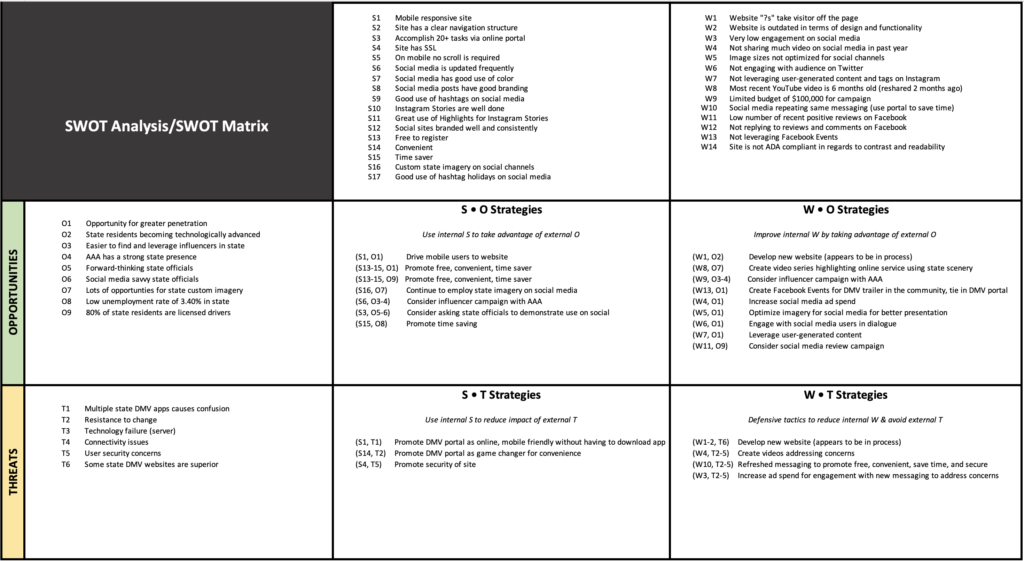SWOT analysis, a fundamental tool in strategic planning, takes a new turn when applied specifically to digital marketing.
Think you know SWOT analysis? Think again. When employed with a focus on digital marketing this foundational instrument in strategic planning undergoes a transformative shift.
The SWOT analysis technique allows businesses, as well as individuals, to assess, analyze, and devise a successful future. But while effective, the basic SWOT approach is a little tired. You look at your internal strengths and weaknesses, and the environmental opportunities and threats. Then, you list them and figure out how you can leverage external opportunities. Helpful, for sure. However, this approach merely scratches the surface.
For several years, I’ve witnessed organizations of all sizes discover the potential of SWOT analysis through a hands-on and collaborative approach and eye on digital marketing.
Most recently, I saw this happen while working as a consultant and private educator for a group of associates at a pharmaceutical company. The key “aha” moments came when participants realized the power of focusing SWOT analysis on specific strategies, channels, or tactics. It was like watching multiple lightbulbs go off. The excitement was palpable as individuals began pinging off each other with ideas.
I’m not alone in thinking SWOT analysis needs a refresh. In fact, the Harvard Business Review has suggested “turning the SWOT process on its head.” I truly believe that a SWOT analysis matrix makes all the difference. By embracing creativity, collaboration, and a strategic mindset, businesses can unlock new opportunities and navigate the digital landscape with confidence. Let’s take a look at how you can add a digital marketing focus to your next SWOT analysis.
Creating your SWOT analysis matrix
The journey begins with the creation of a matrix, where strengths, weaknesses, opportunities, and threats are assigned numerical values. The first way we update our analysis is by adding multiple layers. Rather than examining one strength, we examine the strengths and sequentially number them. This is repeated for each letter in the traditional SWOT analysis.
These values are then matched within a spreadsheet, highlighting intersections that represent a specific strength aligning with a particular opportunity. Doing so allows us to:
- Leverage internal strengths and external opportunities
- Leverage internal strengths to mitigate external threats
- Leverage external opportunities to mitigate internal weaknesses
- Defend external threats and internal weaknesses
This introduction sets the stage for a deeper exploration of applying SWOT analysis to digital marketing, offering a systematic and data-driven approach to strategic decision-making. The goal is to understand the implications of these intersections and uncover strategies to apply in the digital marketing landscape. The result is a practical and tailored approach, maximizing organizational strengths in the face of digital challenges and seizing opportunities.

This matrix, a visual guide, prompts a crucial question: How does this intersection manifest, especially in the context of digital marketing?
Ultimately, this unique matrix becomes the bridge between internal capabilities and external factors. For instance, that pharmaceutical company identified its capital strength and the ongoing opportunities for acquisitions in the industry. Matching these elements in the matrix led to a realization – leveraging cash for acquisitions could be achieved through digital marketing.
Focusing on digital marketing tactics
In the ever-evolving landscape of business, digital marketing has become imperative for organizations seeking relevance and success. The digital world offers unparalleled opportunities for engagement, targeting, and measurement. It should be a strategic focal point for any forward-thinking business.
Yet, keeping up with digital marketing strategies may feel like homework to some businesses. Instead, I invite you to think of digital marketing as your helper in achieving your business goals. In essence, this is what the SWOT analysis matrix does. By shifting the focus to include digital marketing, we can identify intersections and envision solutions. Digital marketing can be the catalyst for your business success.
Whenever I facilitate such a SWOT analysis matrix session, I encourage participants to connect the dots between organizational SWOT and specific departments. This emphasizes the need to tailor strategies for each area. The application of the matrix to digital marketing opened up new perspectives, prompting individuals to consider how weaknesses and opportunities in their departments could be addressed through targeted digital marketing efforts.
By applying our digital marketing lens, we encouraged new discussion. The same tactic could be applied again to a SWOT analysis matrix, but with a research and development or human resources lens, for example.
Facilitating a creative collaboration
Naturally, most businesses and business professionals have completed SWOT analysis before. Generally, those analyses were completed at the high level. In the case of the pharmaceutical company, we included associates from across the company on our analytical journey. Afterward, the associates, accustomed to high-level SWOT analyses, acknowledged the importance of delving deeper and seeking input from various departments, including sales professionals, clinicians, doctors, and researchers.
To fully benefit from this approach, participants must bring creative thinking to the table. The success of this approach lies in its hands-on and collaborative nature. It’s not just about listing weaknesses, but thinking creatively about how to turn them into opportunities. An open mindset is crucial. Participants should be willing to explore innovative solutions without hesitation.
More often than not, participants are eager to join me on this journey. I see rapid engagement and excited exchange of ideas among participants. What’s that old adage – two heads are better than one? The energy generated in these sessions fosters creativity and quick decision-making, and also lends itself to team building.
Thinking beyond small
The applicability of this approach extends beyond large organizations. I’ve seen a state agency successfully utilize this digital marketing SWOT analysis to launch a user-friendly app for license and registration renewals. During another collaboration with a downtown restaurant, we were able to address parking challenges creatively. Their solution? They collaborated with a nearby theater to offer free parking to patrons, turning a weakness into a memorable bit of hospitality.
It may seem like we are thinking small when we zero in on digital marketing. Not so. I would say we are thinking specifically, while acting broadly. Businesses of all sizes can identify and capitalize on their unique strengths and opportunities, and in the process unleash exciting digital marketing opportunities.





